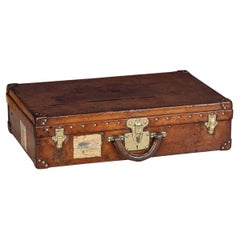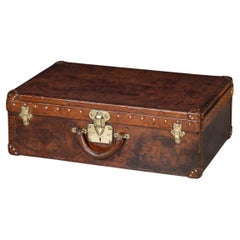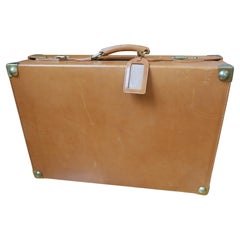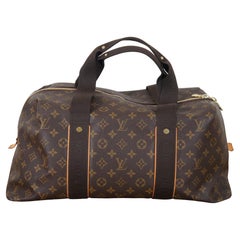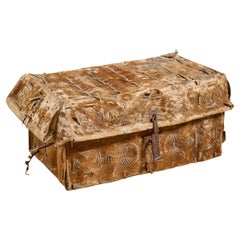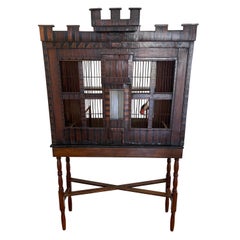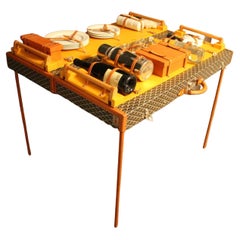Cowhide Home Accents
9
to
5
4
9
9
9
1
1
1
8
2
1
1
2
1,065
2,640
2,463
1,070
721
5
3
3
2
1
5
Material: Cowhide
20th Century Louis Vuitton Suitcase In Natural Cow Hide, France c.1910
Located in Royal Tunbridge Wells, Kent
A highly unusual and exceptionally rare Louis Vuitton suitcase, originating from the early years of the 20th century, distinguishes itself not with the globally renowned monogram canvas but with a distinctive covering crafted from a singular piece of cowhide. This unique piece represents a special order from Louis Vuitton, showcasing the brand's historical commitment to utilising only the finest hides available.
Unlike many of its counterparts, leather trunks and cases of this era often struggle to withstand the test of time, requiring regular treatments to prevent drying and disintegration. Remarkably, this particular example defies the odds, retaining the same supple quality it possessed on the day it first graced the shop floor. This suitcase belongs to Louis Vuitton's collection of "speciality materials," which encompasses a diverse range, including, but not limited to, zinc, copper, crocodile leather, and cow leather.
A brief history about Louis Vuitton trunks: Louis Vuitton was born in 1821 to a farmer and milliner and came from a long-established working-class family in eastern France. Vuitton grew up understanding the effects of perseverance and a strong work ethic from watching his family. At the age of 16, he made the decision to walk 292 miles from his hometown to Paris to try and make a new life for himself. When he arrived the city was in the midst of industrialization with current modes of transportation evolving quickly allowing for longer journeys. With this came the need for sturdy travel pieces.
Vuitton was taken as an apprentice for a successful box maker and packer named Monsieur Marechal. He learned to craft durable containers and how to pack them properly – a well-respected profession at the time.In 1854, years after he had mastered his craft and became well respected for it, Vuitton ventured out on his own to open a shop on Rue Neuve des Capucines. It was here that he began to establish himself as a luggage maker. Then, in 1858, Vuitton designed the first Louis Vuitton steamer trunk. At the time trunks had rounded tops to allow for water to run off but this did not allow for convenient stowage. Vuitton introduced a flat, yet waterproof, trunk that was easily stackable. The first of his trunks were outfitted with a grey canvas referred to as Trianon – it wouldn’t be until several decades later that the signature monogram would be introduced.
With a burgeoning business, Vuitton moved his family and workplace to Asniere, where he employed twenty workers to craft his trunks. By 1900 he would have 100 employees, and in 1914 the company would more than double in size. After years of success, Vuitton began to experiment with the design of his luggage by introducing a new striped canvas pattern (1876) and later the still well-known Damier print (1888). The hand-painted patterns were developed to prevent counterfeits. Even in the late 1800s, Louis Vuitton was enough of a status symbol to warrant counterfeiting. In 1886, his son George invented and patented an ingenious locking system that made it impossible to pick the lock of their trunks. This lock is still used today.
1892 would prove to be a time of mourning for the family as Louis Vuitton passed...
Category
20th Century French Other Cowhide Home Accents
Materials
Brass
20th Century Louis Vuitton Cow Hide Suitcase, France c.1920
Located in Royal Tunbridge Wells, Kent
A highly unusual and exceptionally rare Louis Vuitton suitcase, originating from the early years of the 20th century, distinguishes itself not with the globally renowned monogram canvas but with a distinctive covering crafted from a singular piece of cowhide. This unique piece represents a special order from Louis Vuitton, showcasing the brand's historical commitment to utilizing only the finest hides available.
Unlike many of its counterparts, leather trunks and cases of this era often struggle to withstand the test of time, requiring regular treatments to prevent drying and disintegration. Remarkably, this particular example defies the odds, retaining the same supple quality it possessed on the day it first graced the shop floor. This suitcase belongs to Louis Vuitton's collection of "speciality materials," which encompasses a diverse range, including, but not limited to, zinc, copper, crocodile leather, and cow leather.
A brief history about Louis Vuitton trunks: Louis Vuitton was born in 1821 to a farmer and milliner and came from a long-established working-class family in eastern France. Vuitton grew up understanding the effects of perseverance and a strong work ethic from watching his family. At the age of 16, he made the decision to walk 292 miles from his hometown to Paris to try and make a new life for himself. When he arrived the city was in the midst of industrialization with current modes of transportation evolving quickly allowing for longer journeys. With this came the need for sturdy travel pieces.
Vuitton was taken as an apprentice for a successful box maker and packer named Monsieur Marechal. He learned to craft durable containers and how to pack them properly – a well-respected profession at the time.In 1854, years after he had mastered his craft and became well respected for it, Vuitton ventured out on his own to open a shop on Rue Neuve des Capucines. It was here that he began to establish himself as a luggage maker. Then, in 1858, Vuitton designed the first Louis Vuitton steamer trunk. At the time trunks had rounded tops to allow for water to run off but this did not allow for convenient stowage. Vuitton introduced a flat, yet waterproof, trunk that was easily stackable. The first of his trunks were outfitted with a grey canvas referred to as Trianon – it wouldn’t be until several decades later that the signature monogram would be introduced.
With a burgeoning business, Vuitton moved his family and workplace to Asniere, where he employed twenty workers to craft his trunks. By 1900 he would have 100 employees, and in 1914 the company would more than double in size. After years of success, Vuitton began to experiment with the design of his luggage by introducing a new striped canvas pattern (1876) and later the still well-known Damier print (1888). The hand-painted patterns were developed to prevent counterfeits. Even in the late 1800s, Louis Vuitton was enough of a status symbol to warrant counterfeiting. In 1886, his son George invented and patented an ingenious locking system that made it impossible to pick the lock of their trunks. This lock is still used today.
1892 would prove to be a time of mourning for the family as Louis Vuitton passed...
Category
20th Century French Other Cowhide Home Accents
Materials
Brass
20th Century Louis Vuitton Cow Hide Suitcase, France c.1920
Located in Royal Tunbridge Wells, Kent
A highly unusual and exceptionally rare Louis Vuitton suitcase, originating from the early years of the 20th century, distinguishes itself not with the globally renowned monogram canvas but with a distinctive covering crafted from a singular piece of cowhide. This unique piece represents a special order from Louis Vuitton, showcasing the brand's historical commitment to utilizing only the finest hides available.
Unlike many of its counterparts, leather trunks and cases of this era often struggle to withstand the test of time, requiring regular treatments to prevent drying and disintegration. Remarkably, this particular example defies the odds, retaining the same supple quality it possessed on the day it first graced the shop floor. This suitcase belongs to Louis Vuitton's collection of "speciality materials," which encompasses a diverse range, including, but not limited to, zinc, copper, crocodile leather, and cow leather.
A brief history about Louis Vuitton trunks: Louis Vuitton was born in 1821 to a farmer and milliner and came from a long-established working-class family in eastern France. Vuitton grew up understanding the effects of perseverance and a strong work ethic from watching his family. At the age of 16, he made the decision to walk 292 miles from his hometown to Paris to try and make a new life for himself. When he arrived the city was in the midst of industrialization with current modes of transportation evolving quickly allowing for longer journeys. With this came the need for sturdy travel pieces.
Vuitton was taken as an apprentice for a successful box maker and packer named Monsieur Marechal. He learned to craft durable containers and how to pack them properly – a well-respected profession at the time.In 1854, years after he had mastered his craft and became well respected for it, Vuitton ventured out on his own to open a shop on Rue Neuve des Capucines. It was here that he began to establish himself as a luggage maker. Then, in 1858, Vuitton designed the first Louis Vuitton steamer trunk. At the time trunks had rounded tops to allow for water to run off but this did not allow for convenient stowage. Vuitton introduced a flat, yet waterproof, trunk that was easily stackable. The first of his trunks were outfitted with a grey canvas referred to as Trianon – it wouldn’t be until several decades later that the signature monogram would be introduced.
With a burgeoning business, Vuitton moved his family and workplace to Asniere, where he employed twenty workers to craft his trunks. By 1900 he would have 100 employees, and in 1914 the company would more than double in size. After years of success, Vuitton began to experiment with the design of his luggage by introducing a new striped canvas pattern (1876) and later the still well-known Damier print (1888). The hand-painted patterns were developed to prevent counterfeits. Even in the late 1800s, Louis Vuitton was enough of a status symbol to warrant counterfeiting. In 1886, his son George invented and patented an ingenious locking system that made it impossible to pick the lock of their trunks. This lock is still used today.
1892 would prove to be a time of mourning for the family as Louis Vuitton passed...
Category
20th Century French Other Cowhide Home Accents
Materials
Brass
Vintage Old Timer Suitcase Made from Cowhide with Combination Lock
Located in Vienna, AT
The item on sale is a beautifully constructed suitcase made from cowhide. All the handles, zippers and flaps look untouched. It comes with a matching label for the owner's address an...
Category
Mid-20th Century Austrian Mid-Century Modern Cowhide Home Accents
Materials
Brass
Vintage Louis Vuitton Beaubourg Weekender LV Monogram Canvas Bag France DU2161
Located in Dayton, OH
Vintage Louis Vuitton Beaubourg Weekender duffle bag crafted from brown monogram canvas with cowhide leather trim, canvas straps, and...
Category
Late 20th Century Modern Cowhide Home Accents
Materials
Brass
Hide Trunk with Fur
Located in Chicago, IL
Hide trunk with fur. Made by Gauchos for storage and travel.
Category
1920s Argentine Vintage Cowhide Home Accents
Materials
Cowhide, Hide
Hide Trunk
Located in Chicago, IL
Hide trunk made by gauchos for storage and travel. Nice clasp.
Category
1920s Argentine Vintage Cowhide Home Accents
Materials
Cowhide, Hide
20th Century Louis Vuitton Trunk in Natural Cow Hide, Paris, c.1900
Located in Royal Tunbridge Wells, Kent
A very rare Louis Vuitton hat trunk dating to the early part of the 20th century, covered not in the world famous (but more common) monogram canvas but in a single piece of cow hide. These all-leather trunks were made by special order and Louis Vuitton used...
Category
20th Century British Cowhide Home Accents
Materials
Brass
South American Cowhide & Leather Trunk
Located in New York, NY
South American Colonial (Peruvian 19th Cent) cowhide and leather floor trunk (Bataca) with a geometric strap design.
Category
19th Century Peruvian Spanish Colonial Antique Cowhide Home Accents
Materials
Cowhide, Leather
Related Items
English Birdcage Made from Wood with Date 1740
Located in Southampton, NY
English birdcage made from wood with date 1740 inlaid in the cresting. The tall and narrow shape indicated use as a breading cage, for finches. The bi...
Category
Early 19th Century English Antique Cowhide Home Accents
Materials
Wood
Moynat Trunk, Moynat Steamer Trunk, Moynat Hat Trunk, Moynat Luggage
Located in Saint-Ouen, FR
This beautiful and very rare Moynat trunk features beautiful checkers canvas, chocolate color leather trim, large leather side handles with stamped Moynat flanges and solid brass sta...
Category
Early 20th Century French Cowhide Home Accents
Materials
Brass
H 24.41 in W 24.02 in D 22.05 in
Indian Vintage Bamboo and Woven Rattan Suitcase with Brass Hardware
Located in Yonkers, NY
An Indian vintage bamboo and woven rattan suitcase from the mid 20th century, with brass hardware. Created in India during the midcentury period, this ...
Category
Mid-20th Century Indian Cowhide Home Accents
Materials
Bamboo, Rattan
Vintage Louis Vuitton Suitcase, Monogrammed Coated Canvas, Large-Sized
Located in San Francisco, CA
Vintage classic Louis Vuitton soft side suitcase with leather trims, zipper closure and wheels for easy transport. Open interior for you to pack as you like. Large-sized.
Category
Late 20th Century French Cowhide Home Accents
Materials
Brass
Vintage Louis Vuitton Suitcase, Monogrammed Coated Canvas, Small-Sized
Located in San Francisco, CA
Vintage classic Louis Vuitton soft side suitcase with leather trims, zipper closure and wheels for easy transport. Open interior for you to pack as you like. Small-sized.
Category
Late 20th Century French Cowhide Home Accents
Materials
Brass
20th Century Louis Vuitton Steamer Bag In Monogram Canvas, Made In France
Located in Royal Tunbridge Wells, Kent
A lovely Louis Vuitton steamer travel bag in monogram canvas and natural tan leather, made in France in the latter quarter of the 20th century. Steamer bags have been produced by Lou...
Category
1980s French Other Vintage Cowhide Home Accents
Materials
Leather, Cane
Free Shipping
H 18.51 in W 13.78 in D 7.49 in
Louis Vuitton Suitcase Trunk with Key
Located in North Bergen, NJ
French, 20th century. A Louis Vuitton suitcase with a monogram canvas exterior, leather and brass-bound (all rivets and hardware are marked), opens to fitted interior with removable ...
Category
Early 20th Century Cowhide Home Accents
Louis Vuitton Monogram Toiletry Bag Pochette Pouch 15
Located in Haddonfield, NJ
Monogram LV Toiletry Pochette Pouch 15 Date Code 881 TH, France
Authentic LOUIS VUITTON LV Monogram Toiletry Pouch 15. This cosmetic/ lipstick pouch or sm...
Category
21st Century and Contemporary French International Style Cowhide Home Accents
Materials
Brass
20th Century Louis Vuitton Trunk In Monogram Canvas, France c.1910
Located in Royal Tunbridge Wells, Kent
An exquisite and complete Louis Vuitton trunk from the early part of the 20th century. An absolutely essential item for elite travellers of its time the trunk is adorned in the iconi...
Category
20th Century French Other Cowhide Home Accents
Materials
Brass
20th Century Louis Vuitton Steamer Bag In Monogram Canvas, Made In France
Located in Royal Tunbridge Wells, Kent
A 20th Century Louis Vuitton steamer travel bag, crafted from monogram canvas and natural tan leather, serves as a quintessential representation of the brand's unwavering commitment to a design seamlessly harmonising style and utility. Inspired by the practical proportions of mailbags from the Americas, these bags effortlessly combine chic aesthetics with practical functionality—whether hung on a cabin door, displayed on a deck, or utilised for a spontaneous weekend getaway.
The monogram canvas, adorned with iconic LV initials and floral motifs, stands out not only for its recognisability but also for its exceptional durability. Teamed with natural tan leather, this pairing gracefully matures, developing a lavish patina over time that enhances the bag's inherent character. The enduring design underscores Louis Vuitton's timeless allure, elevating these pieces to coveted collector's items that encapsulate the brand's storied history and commitment to impeccable craftsmanship.
A brief history about Louis Vuitton trunks: Louis Vuitton was born in 1821 to a farmer and milliner and came from a long-established working-class family in eastern France. Vuitton grew up understanding the effects of perseverance and a strong work ethic from watching his family. At the age of 16, he made the decision to walk 292 miles from his hometown to Paris to try and make a new life for himself. When he arrived the city was in the midst of industrialisation with current modes of transportation evolving quickly allowing for longer journeys. With this came the need for sturdy travel pieces.
Vuitton was taken as an apprentice for a successful box maker and packer named Monsieur Marechal. He learned to craft durable containers and how to pack them properly – a well-respected profession at the time.In 1854, years after he had mastered his craft and became well respected for it, Vuitton ventured out on his own to open a shop on Rue Neuve des Capucines. It was here that he began to establish himself as a luggage maker. Then, in 1858, Vuitton designed the first Louis Vuitton steamer trunk. At the time trunks had rounded tops to allow for water to run off but this did not allow for convenient stowage. Vuitton introduced a flat, yet waterproof, trunk that was easily stackable. The first of his trunks were outfitted with a grey canvas referred to as Trianon – it wouldn’t be until several decades later that the signature monogram would be introduced.
With a burgeoning business, Vuitton moved his family and workplace to Asniere, where he employed twenty workers to craft his trunks. By 1900 he would have 100 employees, and in 1914 the company would more than double in size. After years of success, Vuitton began to experiment with the design of his luggage by introducing a new striped canvas pattern (1876) and later the still well-known Damier print (1888). The hand-painted patterns were developed to prevent counterfeits. Even in the late 1800s, Louis Vuitton was enough of a status symbol to warrant counterfeiting. In 1886, his son George invented and patented an ingenious locking system that made it impossible to pick the lock of their trunks. This lock is still used today.
1892 would prove to be a time of mourning for the family as Louis Vuitton passed...
Category
20th Century French Other Cowhide Home Accents
Materials
Brass
Free Shipping
H 23.63 in W 21.66 in D 10.63 in
Vintage Louis Vuitton Suitcase, Monogrammed Coated Canvas, Medium-Sized
Located in San Francisco, CA
Vintage classic Louis Vuitton soft side suitcase with leather trims, zipper closure and wheels for easy transport. Open interior for you to pack as you like. Medium sized.
Category
Late 20th Century French Cowhide Home Accents
Materials
Brass
Louis Vuitton Trunk, Louis Vuitton Suitcase, Vuitton Steamer Trunk, Alzer 75
Located in Saint-Ouen, FR
This piece of luggage is a magnificent Louis Vuitton Alzer monogramm suitcase. This 75 cm suitcase is almost the largest and surely the most luxury one made by Louis Vuitton. It feat...
Category
21st Century and Contemporary French Cowhide Home Accents
Materials
Brass
H 8.67 in W 29.53 in D 19.69 in
Previously Available Items
Leather and Cowhide Veneered Vanity Trunk
Located in Brooklyn, NY
Leather and cowhide veneered trunk, transformed into desk or vanity. When opened, the piece reveals mirror and pull-out drawers. Dimensions: 35.5"W x 23.5"D x 30"H. Ask us about loca...
Category
20th Century Cowhide Home Accents
Materials
Cowhide, Leather
Goyard Trunk, Goyard Picnic Trunk, Goyard Folding Sideboard Table
By Goyard
Located in Saint-Ouen, FR
This picnic trunk is absolutely fantastic.
When it is closed, it features the very famous Goyard chevron canvas, as well as silver steel Goyard stamped l...
Category
Early 2000s French Cowhide Home Accents
Materials
Cowhide, Canvas, Poplar
20th Century Louis Vuitton Unusual Leather Wardrobe Trunk, c.1900
Located in Royal Tunbridge Wells, Kent
One of the most popular and sought after of Louis Vuitton trunks is the gentleman’s wardrobe finished in cowhide leather. Dating to the early part of the 20th century, these covering...
Category
20th Century French Cowhide Home Accents
Materials
Cowhide, Canvas, Wood
20th Century Louis Vuitton Courier Trunk in Natural Cow Hide, Paris, c.1930
Located in Royal Tunbridge Wells, Kent
A very rare Louis Vuitton courier trunk covered in leather. Dating to the early part of the 20th century, covered not in the world famous (but more common) monogram canvas but in a s...
Category
20th Century French Cowhide Home Accents
Materials
Cowhide
H 23.23 in W 43.31 in L 23.23 in
20th Century Louis Vuitton Leather Suitcase in Cow Hide, Paris, circa 1900
Located in Royal Tunbridge Wells, Kent
A very rare Louis Vuitton suitcase dating from the early part of the 20th century, covered not in the world famous (but more common) monogram canvas but in a single piece of cow hide...
Category
20th Century French Cowhide Home Accents
Materials
Cowhide
Free Shipping
H 8.67 in W 26.38 in D 16.93 in
20th Century Louis Vuitton Leather Suitcase in Cow Hide, Paris, circa 1900
Located in Royal Tunbridge Wells, Kent
A very rare Louis Vuitton suitcase dating from the early part of the 20th century, covered not in the world famous (but more common) monogram canvas but in a single piece of cow hide. These all-leather trunks and cases were made by special order and Louis Vuitton used...
Category
20th Century French Cowhide Home Accents
Materials
Cowhide
Free Shipping
H 8.67 in W 24.02 in D 15.36 in
20th Century Louis Vuitton Leather Suitcase in Cow Hide, Paris, circa 1900
Located in Royal Tunbridge Wells, Kent
A very rare Louis Vuitton suitcase dating from the early part of the 20th century, covered not in the world famous (but more common) monogram canvas but in a single piece of cow hide...
Category
20th Century French Cowhide Home Accents
Materials
Cowhide
Free Shipping
H 8.67 in W 24.02 in D 15.36 in
Early 20th Century Swiss Army Cowhide Backpack, circa 1945
Located in San Francisco, CA
About
This is an original Swiss Army cowhide and leather backpack lined with fabric on the inside. The backpack has leather straps and buckles on the top, bottom, outside and insi...
Category
Early 20th Century Swiss Cowhide Home Accents
Materials
Cowhide, Leather
20th Century Louis Vuitton Suitcase in Cow Hide, Paris, circa 1900
Located in Royal Tunbridge Wells, Kent
A very rare Louis Vuitton “malle haute” or “high trunk“. Dating to the early part of the 20th century, covered not in the world famous (but more common) monogram canvas but in a sing...
Category
20th Century French Cowhide Home Accents
Materials
Cowhide
20th Century Louis Vuitton Cylinder Hat Trunk, Paris, circa 1900
Located in Royal Tunbridge Wells, Kent
Antique early 20th century very rare Louis Vuitton hat trunk, covered not in the world famous (but more common) monogram canvas but in a single piece of cow hide. These all-leather trunks were made by special order and Louis Vuitton used...
Category
20th Century French Cowhide Home Accents
Materials
Brass
20th Century Louis Vuitton Suitcase in Cow Hide, Paris, circa 1900
Located in Royal Tunbridge Wells, Kent
Antique 20th century very rare Louis Vuitton suitcase, covered not in the world famous (but more common) monogram canvas but in a single piece of cow hide. These all-leather trunks and cases were made by special order and Louis Vuitton used...
Category
20th Century French Cowhide Home Accents
Materials
Cowhide
Free Shipping
H 8.67 in W 25.99 in D 16.93 in
20th Century Hermès Leather Suitcase in Cow Hide, Paris, circa 1900
By Hermès
Located in Royal Tunbridge Wells, Kent
A very rare Hermès suitcase in natural cow hide covering and brass locks and side latches, made in France at the beginning of the 20th century. A great addition to any collection and...
Category
20th Century French Cowhide Home Accents
Materials
Cowhide
Recently Viewed
View AllMore Ways To Browse
Balinese Carved
Balinese Carved Wood
Louis Vuitton Black And Brass Luggage
Louis Vuitton Leather Hat
Antique Spanish Trunk
Balinese Hand Carved
Large Leather Vintage Trunk
Teak Tree Root
Louis Vuitton Painted Trunk
Vintage Trunk Locks
Vintage Chests And Trunks
Vintage Chest Trunks And Chests
Vintage Trunks Trunks And Chests
Luggage Rest
Louis Vuitton Monogram Hat
Leather Trunk On Stand
Vintage Wood And Metal Trunk
English Leather Trunk

